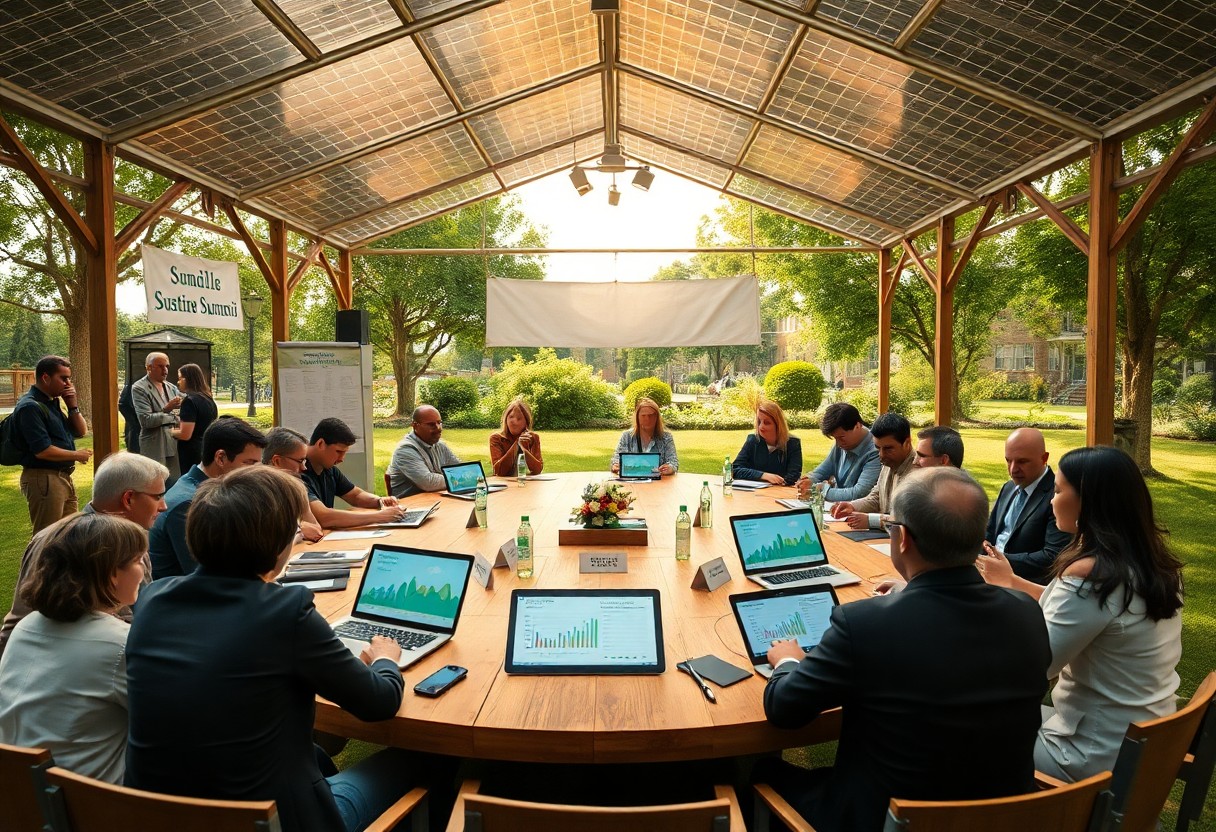With the increasing complexity of environmental issues, pursuing a Master of Environmental Governance (M.E.G.) can empower you with the skills and knowledge necessary to tackle pressing ecological challenges. This advanced degree focuses on the intersection of policy, management, and sustainable development, preparing you to drive change in various sectors. By engaging with critical concepts and real-world applications, your journey through this program will equip you to influence environmental policies and make informed decisions. Explore how the M.E.G. can enhance your career and contribute to a more sustainable future.
Key Takeaways:
- The Master of Environmental Governance (M.E.G.) program focuses on equipping students with the skills necessary to address complex environmental challenges through an interdisciplinary approach, combining policy, science, and management.
- Graduates of the M.E.G. program are trained to become leaders and decision-makers in various sectors, including government, non-profits, and private industries, promoting sustainable practices and effective environmental stewardship.
- The curriculum often emphasizes real-world applications and active participation in projects, allowing students to engage with communities, organizations, and current environmental issues, fostering practical experience and networking opportunities.

The Evolution of Environmental Governance
The journey of environmental governance has seen significant transformations over the decades, adapting to the increasing challenges of ecological degradation and climate change. Early governance frameworks primarily emphasized local environmental concerns, gradually evolving into more complex, multi-layered systems that incorporate scientific innovation, community participation, and cross-border collaborations. This evolution reflects a deeper understanding of the interconnected nature of ecosystems and the necessity for collaborative governance across various scales to address global environmental issues effectively.
Historical Milestones Shaping Policy
Key historical milestones have played a pivotal role in shaping environmental governance policies worldwide. The establishment of the United Nations Environment Programme (UNEP) in 1972 marked a significant turning point, fueling international discourse on sustainable development. Subsequent events, such as the Rio Earth Summit in 1992 and the adoption of the Kyoto Protocol in 1997, solidified global commitments to tackle pressing environmental issues, fostering greater accountability and collective action among nations.
The Role of International Agreements
International agreements serve as vital frameworks that guide nations in their environmental governance strategies. Treaties such as the Paris Agreement illustrate how countries commit to reducing greenhouse gas emissions and adapting to climate impacts. These accords facilitate collaboration, ensuring that nations are held accountable for their commitments while providing mechanisms for resource sharing and technological support to address environmental challenges efficiently.
The Paris Agreement, for example, reflects a significant evolution in global environmental governance, as it emphasizes nationally determined contributions (NDCs) that allow countries to set their own targets based on unique circumstances. This flexibility recognizes the varied capabilities of nations and promotes inclusivity, encouraging proactive measures from both developed and developing countries. The continual ratification and revision of such agreements capture the dynamic nature of climate action and highlight the necessity for ongoing adaptation in the face of evolving environmental threats and societal demands.
Interdisciplinary Approaches in Environmental Governance
Embracing interdisciplinary approaches enhances environmental governance by drawing on diverse fields such as political science, sociology, economics, and ecology. This integration promotes a more holistic understanding of environmental challenges, allowing for the development of comprehensive strategies that can effectively address complex issues like climate change and biodiversity loss. By pooling expertise, stakeholders can collaboratively design policies that are both scientifically sound and socially equitable, ensuring a sustainable future for generations to come.
Integrating Science and Policy
Effective environmental governance relies on seamlessly integrating scientific insights into policy frameworks. By utilizing empirical data and research findings, policymakers can craft regulations and initiatives that are grounded in reality, leading to targeted interventions that address pressing environmental concerns. This synergy fosters a climate where scientific research is not only respected but is also actively employed in shaping laws and regulations, bridging the gap between theory and practice.
The Influence of Economics on Environmental Decision-Making
Economic factors play a significant role in shaping environmental policies and decisions. Understanding the fiscal implications of environmental regulations can drive both governmental and corporate actions. Cost-benefit analyses, economic incentives, and market-based approaches often influence how stakeholders prioritize environmental issues. You may observe that decisions are frequently swayed by financial feasibility, sometimes leading to compromises that prioritize short-term gains over long-term sustainability.
Economic considerations are deeply intertwined with environmental decision-making processes. For instance, cost-benefit analyses can reveal the financial burden of pollution versus the potential savings from cleaner technologies, which may influence whether a government invests in renewable energy. Policy instruments like carbon pricing harness market forces to encourage reductions in emissions, aligning economic incentives with climate goals. Case studies show that regions adopting green economy models often experience job growth alongside environmental improvements, demonstrating that economic motives can align with sustainable practices. Ultimately, understanding these economic influences empowers you to advocate for effective policies that promote both ecological health and economic viability.
Empowering Local Communities through Governance
Effective governance at the local level empowers communities to take charge of their environmental challenges while fostering sustainable development. Local governance equips citizens with the tools and authority to influence decisions that affect their surroundings. With active participation, communities can collaborate to create innovative solutions that address their unique environmental issues, promote resilience, and enhance overall well-being.
Grassroots Movements and Their Impact
Grassroots movements have proven to be powerful catalysts for change, mobilizing communities around shared environmental goals. These movements often emerge from local concerns, enabling participants to advocate for policies that protect their natural resources and improve their quality of life. By harnessing local knowledge and resources, grassroots efforts elevate community voices, ensuring that local needs are prioritized in environmental governance.
Case Studies of Successful Local Initiatives
Examining successful local initiatives reveals several best practices that can serve as models for future governance efforts. By analyzing various case studies, you’ll gain insight into how local communities have effectively tackled pressing environmental issues and fostered sustainable practices. Here are some noteworthy examples:
- 1. The Urban Forest Project – 30% Increase in Canopy Cover: A community-led project in a Midwestern city that successfully increased urban canopy cover by 30% over five years, improving air quality and reducing heat island effects.
- 2. Water Conservation Initiative – 25% Reduction in Water Usage: A small town in California implemented a conservation program that resulted in a 25% decrease in water consumption during a severe drought.
- 3. Community Solar Energy Cooperative – 50% Increase in Renewable Energy: A cooperative model in Vermont that enabled locals to invest in solar energy, resulting in a 50% increase in renewable energy use within the community.
- 4. Plastic Waste Reduction Campaign – 40% Decrease in Plastic Waste: A grassroots campaign in a coastal city that encouraged businesses and residents to reduce single-use plastics, achieving a 40% drop in plastic waste in just two years.
These case studies illustrate the effectiveness of local initiatives in addressing environmental issues through collective action and governance. For instance, the Urban Forest Project’s increase in canopy cover not only beautified the area but also enhanced biodiversity and improved mental well-being for residents. Similarly, the Water Conservation Initiative highlights the importance of community-driven strategies in responding to climate pressures. By showcasing these successful efforts, you can gain valuable insights into the potential impact of empowered local governance in fostering environmental sustainability.
The Role of Technology in Modern Governance
Your understanding of governance expands significantly when you consider the integration of technology. Modern governance leverages data analytics, artificial intelligence, and digital communication tools to enhance decision-making processes. These innovations streamline operations, empower citizens with information, and foster collaboration across sectors. Moreover, they enable real-time data collection and analysis, allowing for more adaptive and responsive governance practices that can effectively tackle pressing environmental challenges.
Innovations Driving Sustainable Practices
Innovative technologies, such as smart sensors and drone mapping, are revolutionizing sustainable practices in environmental governance. By providing accurate and timely data, these tools enable organizations to monitor ecosystems, manage resources efficiently, and respond effectively to environmental issues. For instance, satellite imagery is now used to track deforestation in real-time, helping regulators make informed decisions that support conservation efforts.
Digital Platforms for Transparency and Accountability
Digital platforms increasingly serve as critical tools for enhancing transparency and accountability in governance. They empower citizens to engage with governmental processes, access crucial information, and hold officials accountable. Platforms like OpenGov and CitizenLab facilitate the sharing of budgetary data, project progress, and environmental impact assessments, thereby fostering public trust and encouraging civic participation.
By utilizing digital platforms, you can see tangible improvements in transparency and accountability within governance systems. These platforms allow you to track the progression of environmental policies, view government budgets, and access data addressing water quality or emissions levels in your area. This ease of access transforms the relationship between citizens and authorities, enabling you to participate actively in dialogues regarding community decisions. Moreover, by creating user-friendly interfaces, these tools have the potential to engage a broader audience, effectively democratizing environmental governance and ensuring that every voice can contribute to the sustainability conversation.

Challenges and Future Directions in Environmental Governance
Environmental governance faces significant challenges that must be addressed to pave the way for a sustainable future. Political inertia, economic constraints, and societal apathy often hinder effective policy implementation. Furthermore, the complexity of environmental issues requires collaborative frameworks and shared responsibility across various sectors and levels of governance. Future directions will need to prioritize adaptive strategies and integrative approaches that are responsive to emerging environmental threats while fostering resilience within communities and ecosystems.
Navigating Political and Economic Resistance
Political and economic resistance often complicates the implementation of effective environmental policies. Your efforts in governance frequently meet obstacles such as lobbying from industries resistant to change, which can sway legislative agendas. Additionally, economic factors play a crucial role, as stakeholders weigh financial implications against long-term environmental benefits. Addressing these resistances involves strategic negotiations, awareness-building, and creating incentives that align environmental goals with economic interests to foster collaborative progress.
Setting Goals for a Sustainable Future
Establishing clear, measurable goals is vital for fostering a sustainable future. These goals should not only focus on reducing carbon emissions or preserving natural habitats but also include social dimensions, such as equity and inclusion. Collaborative frameworks can help unify stakeholders, ensuring that diverse voices contribute to goal-setting processes, paving the way for collective ownership and accountability in achieving ambitious sustainability targets.
By adopting a systems-thinking approach, you can develop comprehensive goals that integrate environmental, economic, and social considerations. For instance, initiatives like the United Nations’ Sustainable Development Goals (SDGs) illustrate how interconnected targets can drive global action. Setting specific metrics such as reducing water usage by 30% within five years or increasing renewable energy use to 50% by a specific date can galvanize support and maintain momentum. Ultimately, clear and strategic goal-setting not only directs action but also inspires collective commitment to forge a sustainable path forward.
Final Words
Taking this into account, pursuing a Master of Environmental Governance (M.E.G.) equips you with the knowledge and skills necessary to address complex environmental challenges. This program empowers you to engage with policy-making, sustainability practices, and community involvement. As you navigate this important field, you will enhance your understanding and ability to devise innovative solutions for a sustainable future. Embrace this opportunity to become a leader in environmental governance, where your contributions can make a significant impact on both local and global scales.

